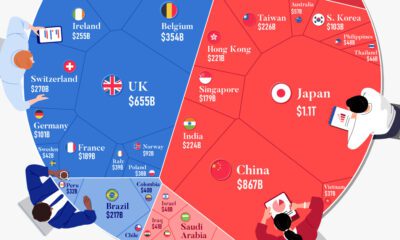
Written By Govind Bhutada
Graphics & Design
- Athul Alexander
Published March 22, 2023
•
Updated March 22, 2023
•
The following content is sponsored by CanAlaska Uranium
5 Ways Nuclear Power Can Enable an Energy Utopia
The phrase Energy utopia describes a hypothetical and sustainable state of the world where energy is clean, affordable, and accessible. Despite the challenges on the road to achieving an energy utopia, such a state is attainable if the world invests in clean, reliable technologies that can meet our rising energy needs—and nuclear power is one such technology.This infographic sponsored by CanAlaska Uranium explores five ways nuclear power can unlock a state of energy utopia. This is Part 2 of 4 in the Road to Energy Utopia series.
#1: High Reliability
Nuclear power plants run 24/7 and are the most reliable source of sustainable energy.
Nuclear electricity generation remains steady around the clock throughout the day, week, and year. Meanwhile, daily solar generation peaks in the afternoon when electricity demand is usually lower, and wind generation depends on wind speeds.As the use of variable solar and wind power increases globally, nuclear offers a stable and reliable backbone for a clean electricity grid.
#2: Clean Electricity
Nuclear reactors use fission to generate electricity without any greenhouse gas (GHG) emissions.Consequently, nuclear power is the cleanest energy source on a lifecycle basis, measured in CO2-equivalent emissions per gigawatt-hour (GWh) of electricity produced by a power plant over its lifetime.
The lifecycle emissions from a typical nuclear power plant are 273 times lower than coal and 163 times lower than natural gas. Furthermore, nuclear is relatively less resource-intensive, allowing for lower supply chain emissions than wind and solar plants.
#3: Stable Affordability
Although nuclear plants can be expensive to build, they are cost-competitive in the long run.
Most nuclear plants have an initial lifetime of around 40 years, after which they can continue operating with approved lifetime extensions. Nuclear plants with lifetime extensions are the cheapest sources of electricity in the United States, and 88 of the country’s 92 reactors have received approvals for 20-year extensions.
Additionally, according to the World Nuclear Association, nuclear plants are relatively less susceptible to fuel price volatility than natural gas plants, allowing for stable costs of electricity generation.
#4: Energy Efficiency
Nuclear’s high energy return on investment (EROI) exemplifies its exceptional efficiency.
EROI measures how many units of energy are returned for every unit invested in building and running a power plant, over its lifetime. According to a 2018 study by Weissbach et al., nuclear’s EROI is 75 units, making it the most efficient energy source by some distance, with hydropower ranking second at 35 units.
#5: Sustainable Innovation
New, advanced reactor designs are bypassing many of the difficulties faced by traditional nuclear plants, making nuclear power more accessible.
- Small Modular Reactors (SMRs) are much smaller than conventional reactors and are modular—meaning that their components can be transported and assembled in different locations.
- Microreactors are smaller than SMRs and are designed to provide electricity in remote and small market areas. They can also serve as backup power sources during emergencies.
These reactor designs offer several advantages, including lower initial capital costs, portability, and increased scalability.
A Nuclear-Powered Future
Nuclear power is making a remarkable comeback as countries work to achieve climate goals and ultimately, a state of energy utopia.
Besides the 423 reactors in operation worldwide, another 56 reactors are under construction, and at least 69 more are planned for construction. Some nations, like Japan, have also reversed their attitudes toward nuclear power, embracing it as a clean and reliable energy source for the future.
CanAlaska is a leading exploration company in the Athabasca Basin, the Earth’s richest uranium depository. Click here to learn more now.
In part 3 of the Road to Energy Utopia series, we explore the unique properties of uranium, the fuel that powers nuclear reactors.

Please enable JavaScript in your browser to complete this form.Subscribe to our free newsletter and get your mind blown on a daily basis: *Sign up
Related Topics: #energy transition #canalaska-uranium #canalaska #energy utopia #uranium #nuclear power #electricity
Click for Comments
var disqus_shortname = "visualcapitalist.disqus.com";
var disqus_title = "5 Ways Nuclear Power Can Enable an Energy Utopia";
var disqus_url = "https://www.visualcapitalist.com/sp/5-ways-nuclear-power-can-enable-an-energy-utopia/";
var disqus_identifier = "visualcapitalist.disqus.com-156412";
You may also like
-

Central Banks23 hours ago
Which Countries Hold the Most U.S. Debt?
Foreign investors hold $7.3 trillion of the national U.S. debt. These holdings declined 6% in 2022 amid a strong U.S. dollar and rising rates.
-

Investor Education3 days ago
Visualizing 90 Years of Stock and Bond Portfolio Performance
How have investment returns for different portfolio allocations of stocks and bonds compared over the last 90 years?
-

Economy3 days ago
Visualizing the Link Between Unemployment and Recessions
This infographic examines 50 years of data to highlight a clear visual trend: recessions are preceded by a cyclical low in unemployment.
-

Culture5 days ago
Mapped: The World’s Happiest Countries in 2023
Where do the happiest people on earth live? This map is a snapshot of the world’s most (and least) happy countries in 2023.
-

Money1 week ago
The Richest People in the World in 2023
The world’s five richest people are worth a combined $729 billion. From luxury moguls to Asia’s rising titans, we show the richest in 2023.
-

Mining1 week ago
Charted: 30 Years of Central Bank Gold Demand
Globally, central banks bought a record 1,136 tonnes of gold in 2022. How has central bank gold demand changed over the last three decades?
Subscribe
Please enable JavaScript in your browser to complete this form.Join the 380,000+ subscribers who receive our daily email *Sign Up
The post 5 Ways Nuclear Power Can Enable an Energy Utopia appeared first on Visual Capitalist.